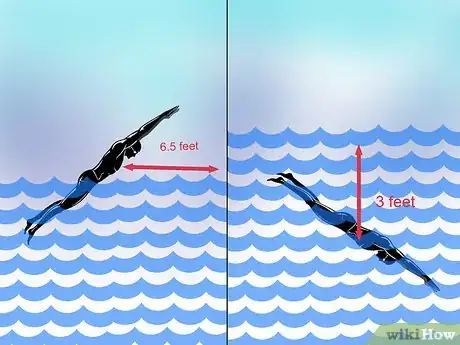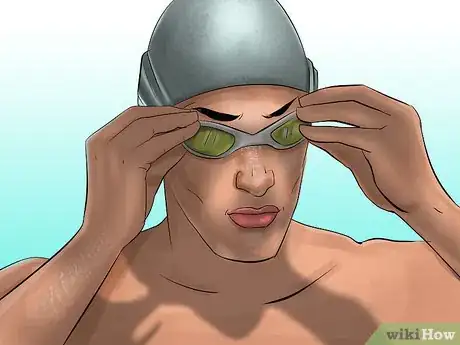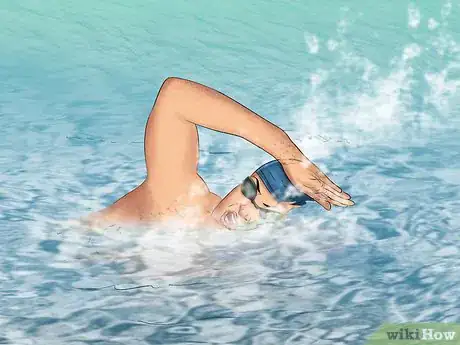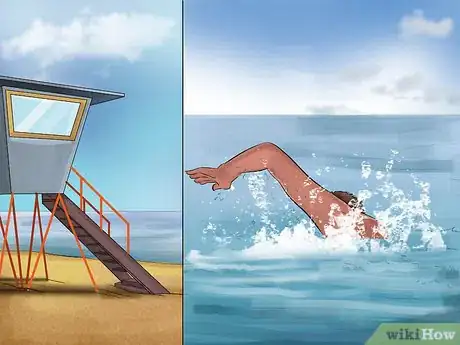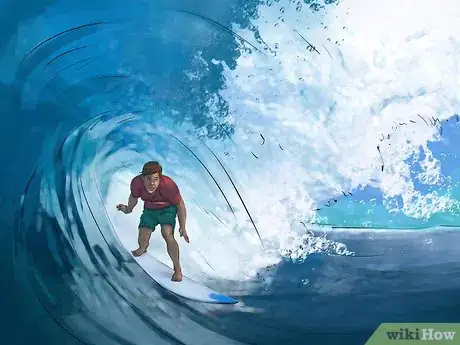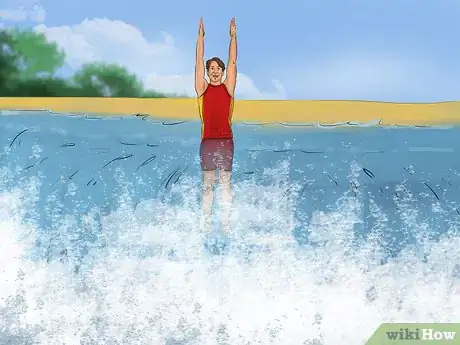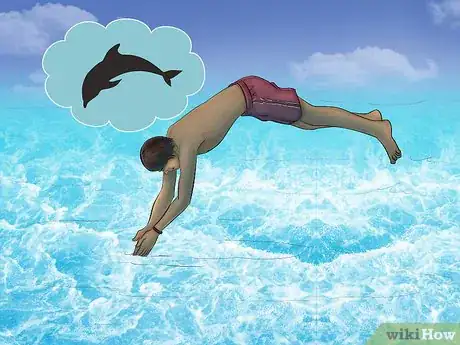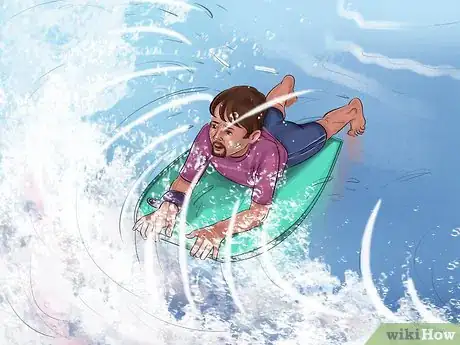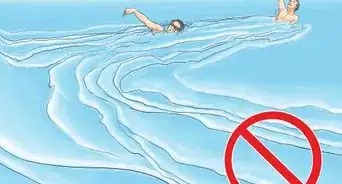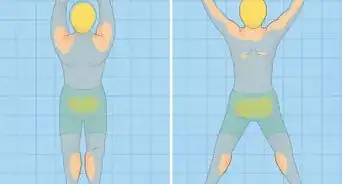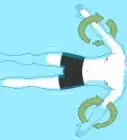This article was co-authored by Brad Hurvitz. Brad Hurvitz is a Certified Swimming Instructor for My Baby Swims, an adolescent swimming school based in La Jolla, California. Brad is trained as an Infant Swimming Resource (ISR) instructor with ISR's Self-Rescue® program. He specializes in training children aged six months to six years of age survival skills like floating on their back to breathe and swimming back to the wall, while also educating parents on how to better keep their kids safe. He has a Master of Business Administration from Oregon State University.
There are 9 references cited in this article, which can be found at the bottom of the page.
This article has been viewed 124,651 times.
Swimming through waves is an important skill to have if you want to spend time in the ocean. It is important to remain relaxed and stay in tune with the movement of the waves. Adjust your breathing to swim through unpredictable waves and keep up your momentum no matter what. Dive under waves when necessary, or attempt to ride over them if they are under five feet.
Steps
Diving under the Waves
-
1Dive early to get under large waves. Some waves are too big to swim through and should be avoided by diving under them. Dive when about you are about 5 to 6 feet (1.5 to 1.8 m) away from the approaching wave to give yourself enough time to get under it. Dive approximately 3 to 4 feet (0.91 to 1.22 m) under the wave, swim forward as much as you can under the wave and emerge the other side.[1]
-
2Adjust your breathing and hold your breath when necessary. Unpredictable waves will mean sudden bursts of water hitting you head on, from behind, or on the side. Adjust your breathing as much as possible by turning your head to take a breath whenever you need to. If a wave comes too quickly to take a clear breath, hold your breath to keep from swallowing or inhaling water.[2]Advertisement
-
3Extend your body horizontally under the wave. Diving under a wave does not simply mean ducking under it, but submerging your entire body and navigating underneath it until it passes. Once you have dived under the surface of the water, keep your body in a horizontal position as you swim underwater. This will ensure that you don't come up to soon and get knocked back by the wave.[3]
-
4Wear surfing goggles. While wearing safety goggles may not look cool at the beach, it is the best way to see clearly underwater when diving and to navigate yourself safely under waves.[4] If you have vision problems, they will also allow you to wear prescription contacts without the risk of losing them or getting an infection. Purchase surfing goggles at a surf shop or online.[5]
- You can also purchase special surfing goggles with prescription or polarized lenses.
-
5Practice diving under small or flat waves. Before attempting to dive under large waves, it is best to get a feel for the process and learn how to build momentum and hold your body. Practice on small or flat waves in a small cove before moving onto big, ocean waves. Ask local surfers for advice about where to go to make sure you don't practice in a spot with hidden dangers, like strong riptides, large rocks, or heavy reef.[6]
-
6Dive under supervision. It is important to have help available to you in the event of an emergency when you are getting used to diving under waves. Practice diving in an area that is supervised by a surf lifeguard, in a spot that is in sight of the on-duty lifeguard's watch station. Alternatively, enlist the help of a private instructor or experienced surfer who is trained in first aid.[7]
Getting under Waves with a Surfboard
-
1Time your duck dive for the emergence of a wave. Duck diving, or passing underneath a wave with your surfboard, is an inevitable part of the surfing experience. Watch the waves and try to time your dive for the point when a wave first starts bouncing upwards from the surface of the water. At this moment, the emerging wave will create a pocket underneath it that will be easy for you to slip through.
-
2Paddle hard towards the wave. Momentum is a key part of successful duck diving and will make the entire process easier. Paddle as hard and fast as you can towards the wave. The momentum you build will allow you to slip under the wave without having to go too deep.
- As a general rule, try to start paddling about 6.5 feet (2.0 m) away from the wave so you can swim enough to create momentum.[8]
-
3Push down on your surfboard when you are a surfboard-length away from the wave. Grab the rails of your surfboard and use your upper body to push downwards as hard as you can until your body submerges into the water. Straighten your arms as you push in order to use as much force as possible.
- Keep your eyes open under water to direct yourself safely under the wave. To protect your eyes, it is best to wear surfing goggles.
-
4Bring down the tail of your board with your foot or knee. You will need to bring the back of your surfboard downwards in order to fully submerge it into the water and under the wave. Depending on what is more comfortable for you, press your knee or foot onto the traction pad at the back of your board. This motion will help you board enter under the water and bring it parallel to the bottom when the wave passes over you.[9]
- To help push down the back of the board, lift your other leg upwards to shift more weight onto your foot or knee.
-
5Bring your board upward when the wave passes. As you feel the wave pass over you, use your hands to angle the nose of your surfboard upwards. Press your body to your board and allow yourself to float upwards to the surface. Be prepared to paddle as soon as you emerge from the water.
- As the wave passes, you will feel the momentum of the water rushing over you.
Perfecting the Dolphin Dive
-
1Position your arms and bend your knees when a wave approaches. The dolphin dive depends on the strength of your legs to project you up and back into water in a quick burst, the way dolphins dive in an out of water. As you see a wave approaching, press your feet firmly onto the sand under you and bend your knees. Bring your arms up straight above you, pressing them to the sides of your head.[10]
- This dive can be done in any water above knee height, but shallow enough to stand in.
-
2Jump and curve your body into the water towards the sand. As the wave crashes forward, jump out of the water and curve your body to launch back into it. Keep your arms and legs straight but bend at the waist to angle your dive. Aim to dive deep enough to touch the sand with your fingertips.[11]
-
3Hold yourself in position as the wave passes over you. Stay in the deepest spot under the wave while it crashes over you. Hold your breath and keep your muscles tight to hold your position. Brace yourself by planting your fingers into the sand, if necessary.[12]
-
4Move forward along the sand before coming up. As you feel the wave passing over you, start advancing along the sand. Use your fingers to touch the ground and move yourself forward without surfacing. After a few seconds, resurface.[13]
- Take a deep breath and dive again if another wave is coming.
Community Q&A
-
QuestionWhat happens if the waves keep on pulling me back to the sea?
 Community AnswerMost of the time, waves will be pushing you toward the shore. Water pushed shoreward by waves has gravity encouraging it to go back out, so rip currents form. There's plenty of online advice for rips; in the US, check the National Weather Service, which provides rip current advisories and safety information. Most rip currents don't go too far, but they can be fast, so don't try to swim against the current. If you want to get out of the current, try swimming at a right angle to it. Or ride it out till it dissipates. Or request help.
Community AnswerMost of the time, waves will be pushing you toward the shore. Water pushed shoreward by waves has gravity encouraging it to go back out, so rip currents form. There's plenty of online advice for rips; in the US, check the National Weather Service, which provides rip current advisories and safety information. Most rip currents don't go too far, but they can be fast, so don't try to swim against the current. If you want to get out of the current, try swimming at a right angle to it. Or ride it out till it dissipates. Or request help. -
QuestionHow do I dive under a wave?
 Community AnswerGo into the water then wait then the wave will pass you.
Community AnswerGo into the water then wait then the wave will pass you.
References
- ↑ http://www.active.com/triathlon/articles/how-to-navigate-the-surf-in-a-triathlon?page=2
- ↑ https://loneswimmer.com/2012/05/16/howto-swimming-in-rough-water/
- ↑ https://www.active.com/triathlon/articles/how-to-navigate-the-surf-in-a-triathlon?page=2
- ↑ Brad Hurvitz. Certified Swimming Instructor. Expert Interview. 13 February 2020.
- ↑ http://www.surferdad.co.uk/surf-goggles
- ↑ http://www.prideofmaui.com/blog/maui/beginner-surf-breaks-maui.html
- ↑ Brad Hurvitz. Certified Swimming Instructor. Expert Interview. 13 February 2020.
- ↑ http://barefootsurftravel.com/livemore-magazine/how-to-duck-dive
- ↑ http://barefootsurftravel.com/livemore-magazine/how-to-duck-dive
- ↑ http://www.active.com/swimming/articles/survive-the-surf-entrances-and-exits-in-open-water-swims-875106
- ↑ http://www.active.com/swimming/articles/survive-the-surf-entrances-and-exits-in-open-water-swims-875106
- ↑ http://www.active.com/swimming/articles/survive-the-surf-entrances-and-exits-in-open-water-swims-875106
- ↑ http://www.active.com/swimming/articles/survive-the-surf-entrances-and-exits-in-open-water-swims-875106
